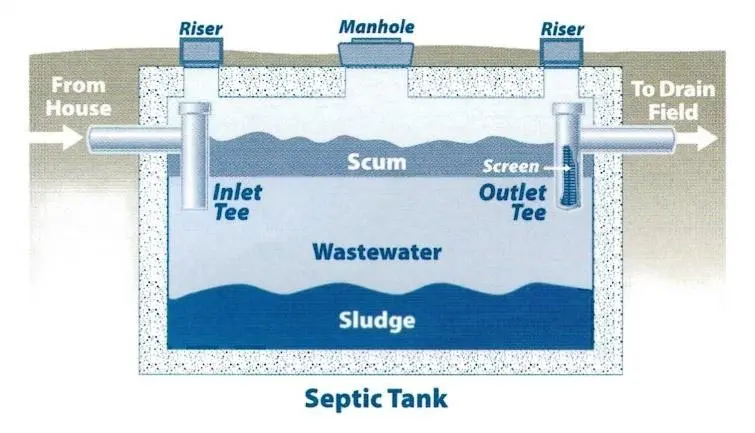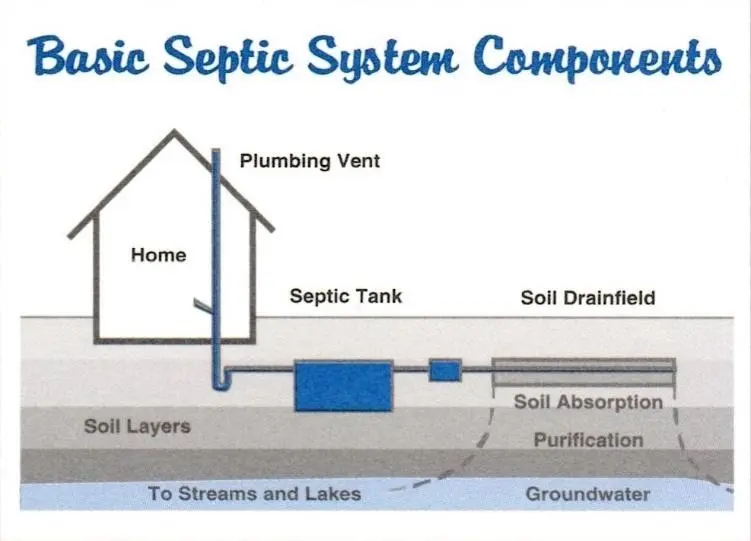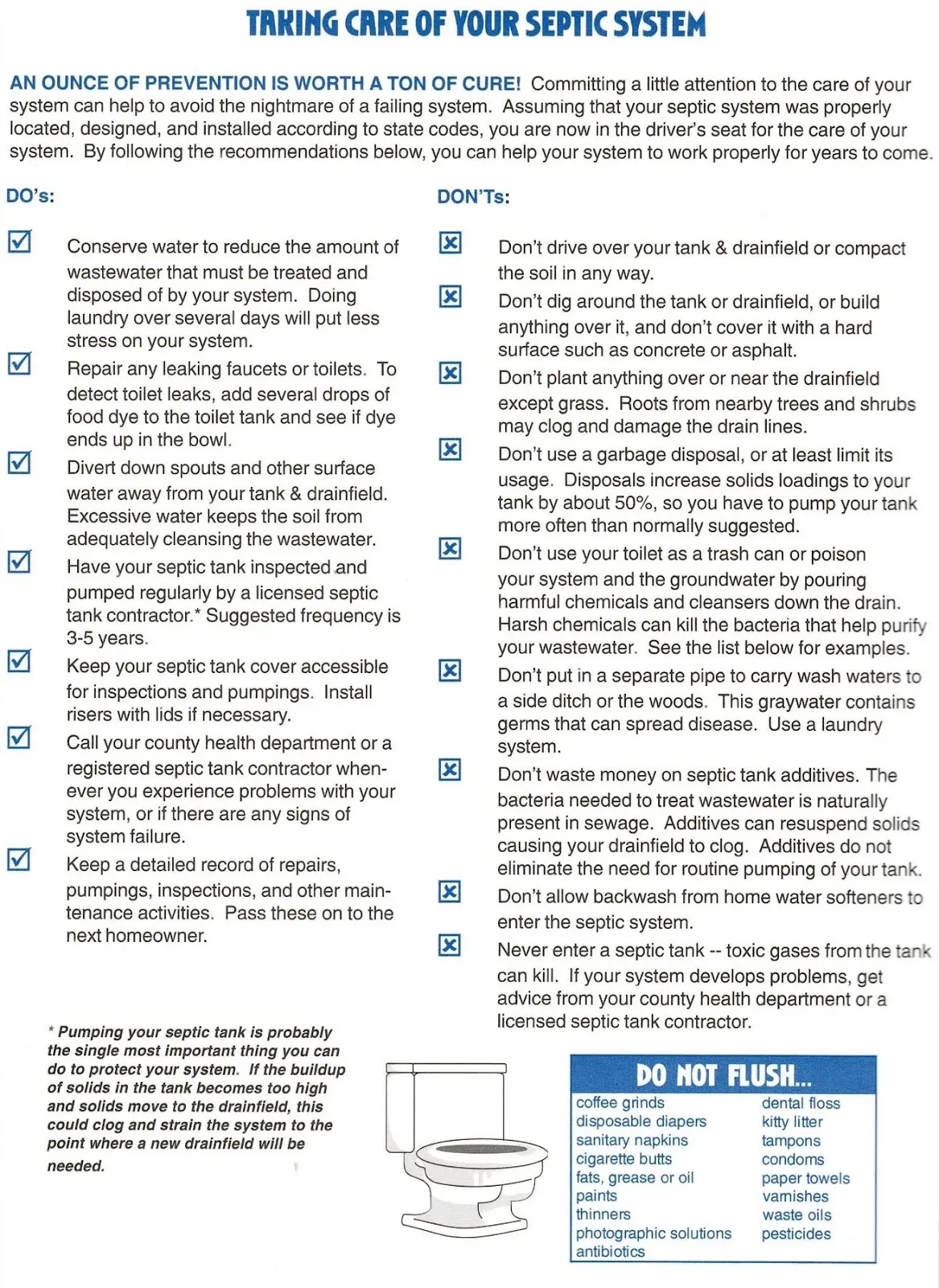Resources
- Septic Information
- Frequently Asked Questions
- Useful Links
What Is A Septic System And How Does It Work?
A septic system is an economically efficient and environmentally safe means of disposing domestic wastewater. It uses natural processes to decompose solids materials and treat wastewater before it is returned to the environment. A septic system typically consists of an inlet pipe from the home, a septic tank, a drainfield, and soil. The septic tank is a water tight container made of concrete, fiberglass, or polyethylene. As wastewater flows from the home into the tank, the heavier solids settle at the bottom forming a sludge layer, while the lighter solids, greases, and oils float to the top and form a scum layer. Compartments and a T-shaped outlet pipe prevents the sludge and scum from entering the drainfield area. The liquid wastewater, or effluent, flows from the tank into the drainfield for further treatment by the soil. Traditional drainfields consisted of gravel-filled trenches which distributed effluent via perforated pipes. Today, we have alternative drainfield materials such as chambers, multipipe, styrofoam aggregates, and even drip irrigation.


Septic Systems Do's And Don'ts

A septic tank uses a natural process to treat and dispose of the wastewater generated in your home. It typically consists of an inlet pipe from the home, a septic tank, a drainfield, and soil. The septic tank is a water tight container made of concrete, fiberglass, or polyethylene. As wastewater flows from the home into the tank, the heavier solids settle at the bottom forming a sludge layer, while the lighter solids, greases, and oils float to the top and form a scum layer. Compartments and a T-shaped outlet pipe prevents the sludge and scum from entering the drainfield area. The liquid wastewater, or effluent, flows from the tank into drainfield for further treatment by the soil. Traditional drainfields consisted of gravel-filled trenches which distributed effluent via perforated pipes. Today, we have alternative drainfield materials such as chambers, multipipe, styrofoam aggregates, and even drip irrigation.
A variety of factors come into play when determining the cost of a septic system; each of these will be discussed in detail with the customer on site. The type of system, size of drainfield, type of soil, depth to the water table, presence of limiting layers, fill requirements, disposal requirements, access to the project site, location of the existing feature such as wells and buildings which require setbacks, and the overall complexity of the project will be considered in determining the cost of a septic system.
Not to fear, most of the time it will only take a few hours after the job starts for your facilities to be back in use.
No. Roots of trees and shrubs can damage and clog your drainfield. Roots can also get into the septic tank, reducing its capacity and possibly blocking the inlet or outlet pipe of the septic tank. In some cases, roots can even crack your septic tank. Planting trees and shrubs on the drainfield will result in a costly repair.
No. Driving and parking cars on drainfields can cause damage, compaction issues, and even crush the drainfield, resulting in a costly repair.
The purpose of having your tank pumped is to remove the solids that have built up in the septic tank, or, in the case of an emergency, to allow for temporary relief. When the solids are allowed to continually build, they will become thick enough to bypass the tank and clog the drainfield, which will eventually lead to system failure. The septic tank will resume normal water level soon after being pumped. It is typical to see water in the tank with only a 12-inch air space; however, the water level must be at or below the bottom of your outlet. When the water level is above the bottom of the outlet, this is an indication the drainfield has at least six inches of ponding and could be experiencing early signs of failure.
This question really depends on the usage. The Department of Health recommends that septic tanks be pumped every 3 to 5 years, the EPA every 3 years, and the Water Management District every 2 to 3 years. Typically, pumping every 3 to 5 years will suffice to keep solids from building up to a level that impacts the efficiency of your system. However, during the recession, COVID-19 pandemic, and even holiday seasons, more people tend to live together and use the facilities of a single household; this increased usage means a septic tank should be pumped more often. We recommend that our customers have their septic tanks pumped out every 2 to 3 years. Ensuring the proper functioning of your system on a regular basis prevents costly repairs down the road.
Depending on usage, it is recommended that you clean your filter once every 6 to 12 months.
There is no conclusive data to support the long-term effectiveness of enzyme use. Septic systems, especially aerobic treatment systems, require a specific balance of bacteria and food. With normal use, the human waste from your body will maintain the correct bacteria necessary in the septic tank. Rather than invest on septic tank additives, we recommend getting your tank pumped on a regular basis, every 2 to 3 years, to ensure solids do not build up.
No. These products are made of cellulose, a non-biodegradable product, that the bacteria in the septic tank cannot breakdown. When these products build up, they can cause blocks in your pipes, back-ups, and even a costly repair. Nothing should be flushed down a toilet except toilet paper.
We do not recommend flushing products even when they are described as “flushable wipes.” These products tend to build up in your system faster than they break down.
Yes. But care should be used not to allow excessive grease or non-biodegradable products such as fruit or vegetable peelings to get into the disposal system. Your septic tank is like a trash can and must be emptied regularly. The more you use the garbage disposal the more often you will need to empty (pump) the septic tank.
Yes. We do offer emergency services, but there is an after-hour charge for emergency pumping on nights and weekends. Please give us a call if you are experiencing a backup and we can walk you through some steps to gain some temporary relief.
Give us a call and we are happy to conduct a quick diagnosis over the phone. If there is a block in your plumbing line, we recommend you get this fixed immediately! Increased waterflow and backups, even over a short period of time, can flood out your drainfield and destroy your system.
Give us a call and we can discuss symptoms over the phone, then schedule a site visit to verify the problem. The only way to verify the cause of the problem is an onsite inspection by a registered licensed septic tank contractor. Unfortunately, most drainfield failures will require a replacement.
We feel incredibly fortunate to live in Brevard County for its unique and abundant natural resources. When not on the job, we enjoy spending time on the water, fishing, diving, kayaking, and watching wildlife. That is why promoting the health and safety of our environment is our top priority both personally and through our business. The mahi mahi logo embodies the mission of our business and helps keep in perspective that after a long hard work week, we get to go fishing!
Contact us for a FREE consultation and estimate.
Serving Brevard, Indian River, and St. Lucie Counties, including Titusville, Port St. John, Cocoa, Rockledge, Viera, Merritt Island, Satellite Beach, Melbourne, Indialantic, Melbourne Beach, Palm Bay, Malabar, Grant-Valkaria, Micco, Roseland, Sebastian, Fellsmere, Vero Beach, Fort Pierce, and more.
Get a Quote Today!
(321) 294-7353
